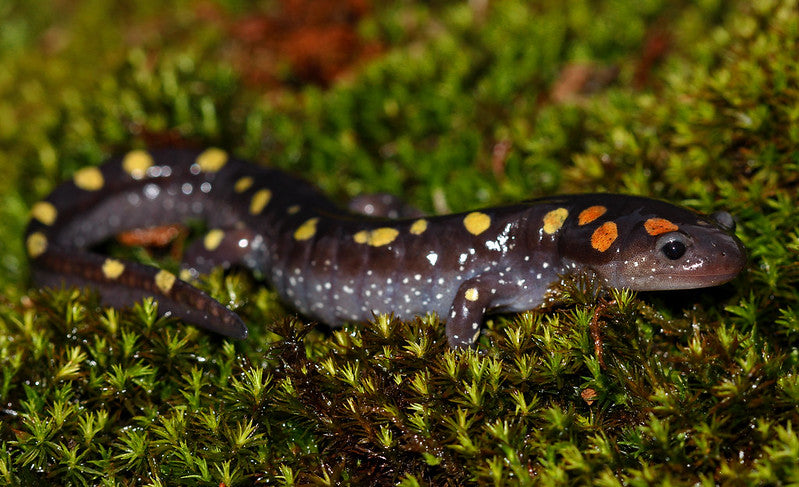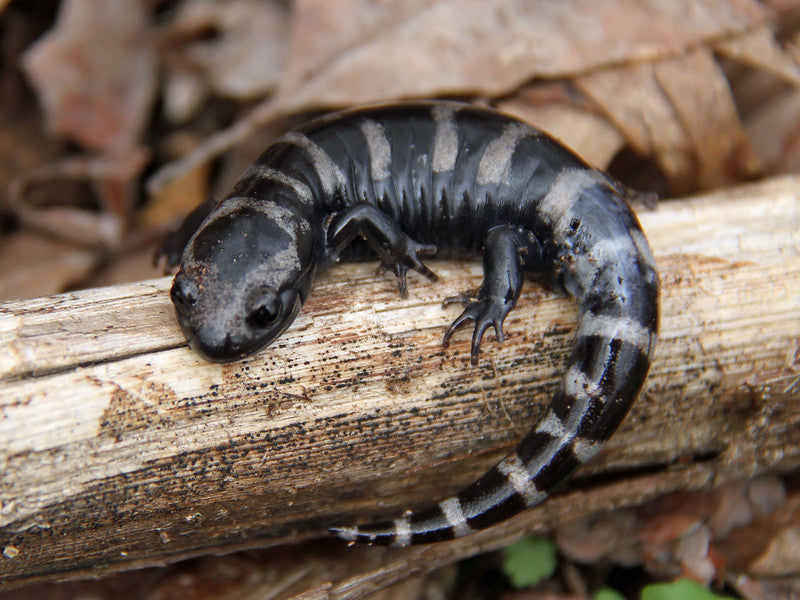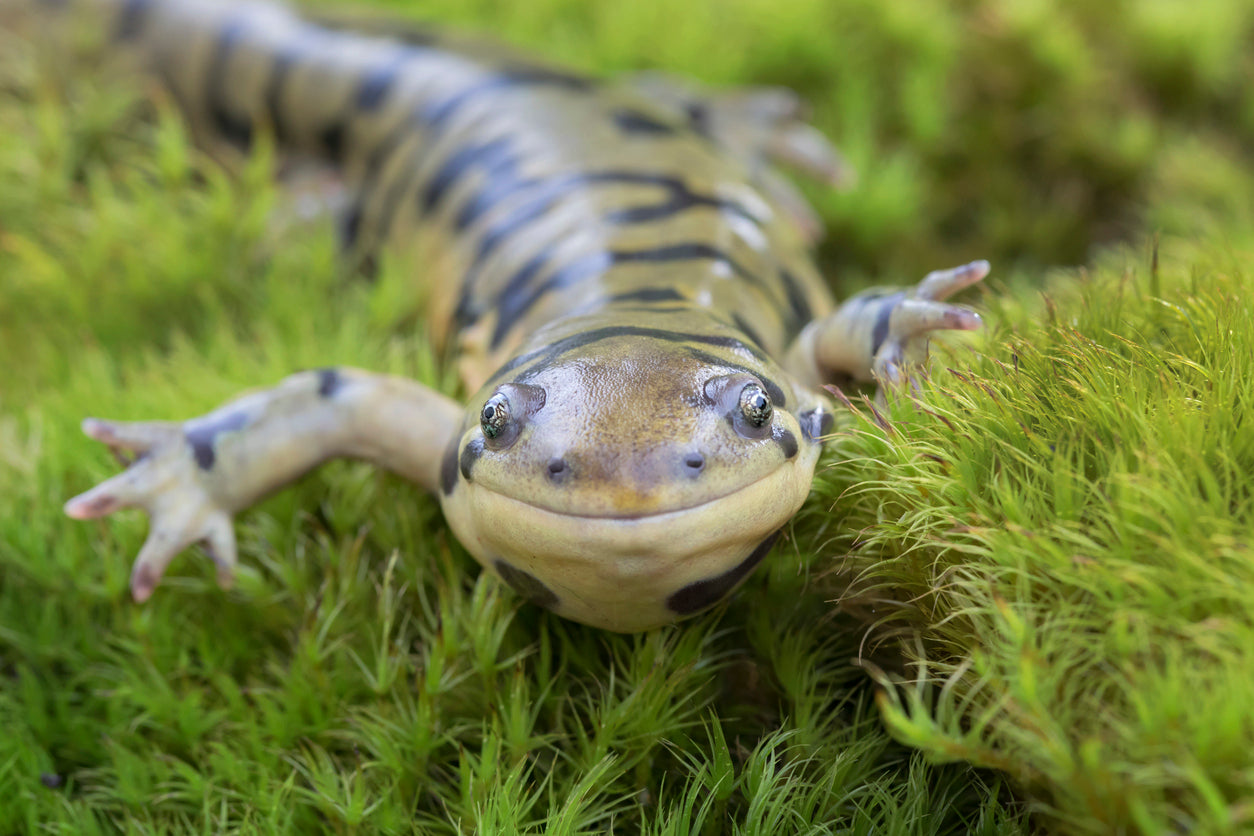Spotted salamanders (Ambystoma maculatum) are large, nocturnal, terrestrial amphibians. They are generally widespread in the eastern half of the United States, excluding Florida. They prefer deciduous forests for habitat, where they often take refuge under leaf litter, fallen logs, and various other debris.
Spotted salamanders are generally 4.4-7.8” long, but they are known to grow as large as 9.8”. They have a fairly typical salamander body, with a large rounded head, bulging dark eyes, robust body, costal grooves, short limbs, and a thick, tapered tail. They have a distinctive appearance with a dark brown or black base color and large yellow or orange spots on their back and sides.
Spotted salamanders are fairly easy to care for, and make fairly good beginner-level amphibians. With good care, they may live for as long as 30 years.
Note: Spotted salamanders may be very common in the US, but you should never take them from the wild to keep as pets! If you want a pet spotted salamander, please purchase one from a breeder.
How much space do spotted salamanders need?
Spotted salamanders are terrestrial, so they don’t need an aquatic area in their enclosure. The minimum size for housing a spotted salamander is 30”L x 12”W x 12”H, or a 20 gallon “long” tank. However, larger is preferred, as their territories in the wild are much larger. We also recommend using a front-opening rather than top-opening enclosure, as this makes maintenance easier and less stressful for the salamander.
Multiple spotted salamanders should not be housed together, as they are a naturally solitary species.
Do spotted salamanders need special lighting?
They seem to be able to survive without it, but it’s still best practice to provide a small amount of UVB lighting for optimal health and wellbeing. Providing UVB lighting to your spotted salamander gives them all of the vitamin D that their body needs, stimulates better appetite and activity, and generally allows them to be healthier than they would be without.
The best UVB bulb for spotted salamanders in a 12” tall enclosure is likely to be the Zoo Med Mini Compact Fluorescent Reptisun 5.0, 13w. This bulb should be housed in a reflective fixture like the 12” Zoo Med Naturalistic Terrarium Hood, and placed on top of the mesh lid. UVB bulbs decay over time, so don’t forget to replace your bulb every 12 months to maintain good performance.
UVB is blocked by glass and plastic, so you can’t give your pet UVB by placing its terrarium in front of an open window. This is also likely to heat the terrarium up to dangerous levels via the greenhouse effect!
Lights should be on for 14 hours/day during summer and 10 hours/day during winter to simulate natural seasonal cycles.
What temperatures do spotted salamanders need?
Spotted salamanders are ectotherms, which means that they rely on the temperature of their environment to help regulate their metabolism and stay healthy.
The enclosure temperature should be maintained between 50-75°F, and never warmer than 75°F, as this is likely to cause heat stress. Measure temperature with a digital probe thermometers, with the probe placed in the middle of the enclosure.
Because their preferred temperature is generally around room temperature, heating equipment is not likely to be necessary. However, make sure you have a reliable method of keeping the room consistently cool during summer if your home tends to get warm during that season.
What humidity levels do spotted salamanders need?
As amphibians, spotted salamanders are very dependent on water. However, once they have metamorphosed past their larval stage, they become poor swimmers and should not have a pool of water in their environment. Average air humidity should stay around 50-80%, as measured by a digital probe hygrometer.
It’s best practice to mist your salamander’s enclosure 1-2x daily with a sprayer to create the right humidity levels. Only use dechlorinated water. Amphibian-safe water conditioner such as Zoo Med Reptisafe is good for treating tap water before use.
What substrate is good for spotted salamanders?
Spotted salamanders require at least 3” of moisture-retentive substrate to cushion their bodies, facilitate burrowing, and help maintain healthy humidity levels. As an added perk, it also tends to make the enclosure more attractive.
This substrate should have small particles and hold moisture well. It should also be able to support plant life if you are using live plants:
Remove waste daily. If you are not using a bioactive paludarium setup, substrate should be replaced every 2 months to maintain good hygiene.
What décor can you use in a spotted salamander terrarium?
It’s terribly boring for a salamander to be stuck in an enclosure with nothing in it except substrate. It doesn’t matter how big the enclosure is if you don’t put things in it for your pet to use and interact with.
Décor options for spotted salamanders include:
- leaf litter
- mopani wood
- cork rounds and flats
- live or artificial plants
- pre-made hides/caves
- artificial ornaments
Whatever you choose to use, make sure that your pet has cover to hide under so they can feel secure in their environment.
What do spotted salamanders eat?
Spotted salamanders are insectivores, which means that they need to eat live insect prey in order to get the nutrition that they need. Your salamander should be fed 3x/week, as much as it will eat in roughly 5 minutes. Feeders should be smaller than the salamander’s head.
Food options for spotted salamanders:
- Crickets
- Dubia roach nymphs
- Earthworms
- Hornworms
- Silkworms
- Snails (captive bred only)
Note: Spotted salamanders may stop eating during breeding season. This is normal and not something to worry about too much.
Supplements
Spotted salamanders need vitamin and mineral supplements to enjoy optimal health. We recommend Repashy Calcium Plus LoD, lightly dusted on their prey at each feeding. Occasionally skipping a dusting is fine.
Do spotted salamanders like to be handled?
Very few amphibians actually “like” to be held, and salamanders are not one of them. Handling should be kept to an absolute minimum, but when you have to grab your salamander, wear a pair of nitrile gloves, use an aquarium net, and gently coax them into a plastic container. If you need to use your hands, wash them thoroughly, then wet with cold water before handling. Always wash your hands after working with your salamander as well!
*This care sheet contains only very basic information. Although it’s a good introduction, please do further research with high-quality sources to obtain additional information on caring for this species.
"Spotted Salamander (Ambystoma maculatum)" by 2ndPeter is licensed under CC BY 2.0.




Leave a comment
This site is protected by hCaptcha and the hCaptcha Privacy Policy and Terms of Service apply.